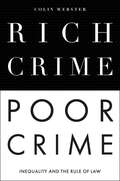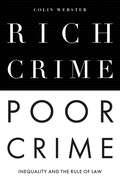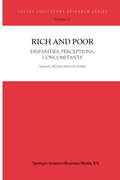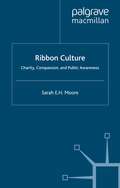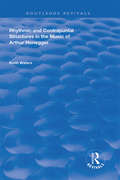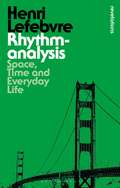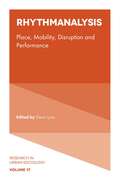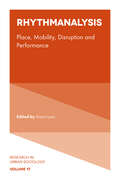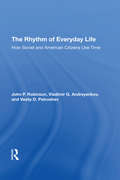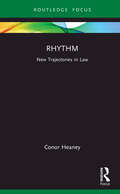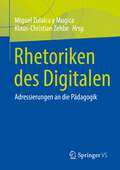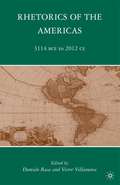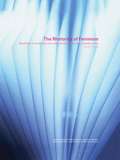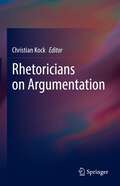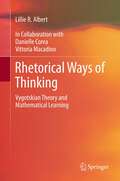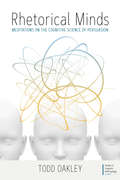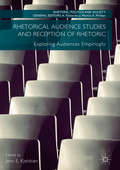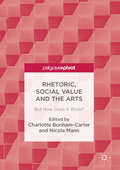- Table View
- List View
Rich Crime, Poor Crime: Inequality and the Rule of Law
by Colin WebsterIn 21st century Britain the rich are protected while the poor punished. Rich Crime, Poor Crime shows how contemporary British society is founded on a legacy of past plunder and dispossession by elites against the rest. Over centuries, power and property have been consolidated in the hands of a few and coded in legal systems that favoured the rich and created extreme inequality. Colin Webster puts a spotlight on Britain’s hereditary and new ruling classes, whose inherited entanglements in land ownership, war and conquest, new world slavery, finance, trade, industry and empire allow them to accumulate and grow capital and wealth at the expense of others. He reveals a system facilitated by political corruption and wealth that accommodates serious wrongdoing – such as corporate, banking and accounting fraud, money laundering and tax evasion – and does substantial harm to fellow Britons. Examining the conditions of extreme inequality that give rise to poor crime and rich crime – and to the social response to both types of crime – we find them to be deeply implicated one with the other. Rich Crime, Poor Crime is vital reading for academics and professionals interested in the fields of history, sociology, criminology, and politics.
Rich Crime, Poor Crime: Inequality and the Rule of Law
by Colin WebsterIn 21st century Britain the rich are protected while the poor punished. Rich Crime, Poor Crime shows how contemporary British society is founded on a legacy of past plunder and dispossession by elites against the rest. Over centuries, power and property have been consolidated in the hands of a few and coded in legal systems that favoured the rich and created extreme inequality. Colin Webster puts a spotlight on Britain’s hereditary and new ruling classes, whose inherited entanglements in land ownership, war and conquest, new world slavery, finance, trade, industry and empire allow them to accumulate and grow capital and wealth at the expense of others. He reveals a system facilitated by political corruption and wealth that accommodates serious wrongdoing – such as corporate, banking and accounting fraud, money laundering and tax evasion – and does substantial harm to fellow Britons. Examining the conditions of extreme inequality that give rise to poor crime and rich crime – and to the social response to both types of crime – we find them to be deeply implicated one with the other. Rich Crime, Poor Crime is vital reading for academics and professionals interested in the fields of history, sociology, criminology, and politics.
Rich and Poor: Disparities, Perceptions, Concomitants (Social Indicators Research Series #15)
by Wolfgang GlatzerThis book is concerned with the question of inequality - which points to a major structural problem in intra-national and inter-national respect. It covers the tension between the rich and poor in less developed countries as well as within richer countries in the process of globalisation. The main topics are the scope of disparities between the rich and poor, people's perception of wealth and poverty, and the concomitants of inequality which shape this relationship and influence its socio-economic consequences. In the tradition of social reporting, the book brings together authors from 15 countries, documenting a broad range of the international inequality debate. The results are related to the trends of socio-economic development, to statistical problems of measuring inequality, and to socio-political problems of integrating society in the facing the challenge of dividing forces. The book is of interest for everybody who wants to understand the tensions of modern world.
Ribbon Culture: Charity, Compassion and Public Awareness
by Sarah E.H. MooreThis book explores the history, meaning, and sociological implications of awareness campaigns, seeing them as personal displays of compassion in a culture where empathy is a by-word for authenticity. It also highlights how charities use awareness campaigns to reach their audience, and the transformation of charity into a commercial enterprise.
Rhythmic and Contrapuntal Structures in the Music of Arthur Honegger
by Keith WatersThis title was first published in 2002. Through analyses of a number of Honegger's compositions, including extended analyses of two of Honegger's orchestral works, "Mouvement symphonique No. 2 (Rugby)" and "Symphonie pour cordes", Keith Waters examines the principles of musical organization in Honegger's music and shows how these principles are based on systematic rhythmic and contrapuntal strategies. Musical form in Honegger's work, the book argues, is articulated by contrapuntal and rhythmic structures rather than by tonal structure, and it is this that provides the source of compositional unity in Honegger's music.
Rhythmic and Contrapuntal Structures in the Music of Arthur Honegger
by Keith WatersThis title was first published in 2002. Through analyses of a number of Honegger's compositions, including extended analyses of two of Honegger's orchestral works, "Mouvement symphonique No. 2 (Rugby)" and "Symphonie pour cordes", Keith Waters examines the principles of musical organization in Honegger's music and shows how these principles are based on systematic rhythmic and contrapuntal strategies. Musical form in Honegger's work, the book argues, is articulated by contrapuntal and rhythmic structures rather than by tonal structure, and it is this that provides the source of compositional unity in Honegger's music.
Rhythmanalysis: Space, Time and Everyday Life (Bloomsbury Revelations)
by Henri LefebvreRhythmanalysis displays all the characteristics which made Lefebvre one of the most important Marxist thinkers of the twentieth century. In the analysis of rhythms -- both biological and social -- Lefebvre shows the interrelation of space and time in the understanding of everyday life.With dazzling skills, Lefebvre moves between discussions of music, the commodity, measurement, the media and the city. In doing so he shows how a non-linear conception of time and history balanced his famous rethinking of the question of space. This volume also includes his earlier essays on "The Rhythmanalysis Project" and "Attempt at the Rhythmanalysis of Mediterranean Towns."
Rhythmanalysis: Space, Time and Everyday Life (Bloomsbury Revelations)
by Henri Lefebvre Gerald Moore Stuart EldenRhythmanalysis displays all the characteristics which made Lefebvre one of the most important Marxist thinkers of the twentieth century. In the analysis of rhythms -- both biological and social -- Lefebvre shows the interrelation of space and time in the understanding of everyday life.With dazzling skills, Lefebvre moves between discussions of music, the commodity, measurement, the media and the city. In doing so he shows how a non-linear conception of time and history balanced his famous rethinking of the question of space. This volume also includes his earlier essays on "The Rhythmanalysis Project" and "Attempt at the Rhythmanalysis of Mediterranean Towns."
Rhythmanalysis: Place, Mobility, Disruption and Performance (Research in Urban Sociology #17)
by Dawn LyonThis collection brings together new and original research on the concept and practice of ‘rhythmanalysis’ in urban sociology as a means to analyse the relationship between the time and space of the city. Originally proposed by French philosopher and urban scholar, Henri Lefebvre and his collaborator, Catherine Régulier, in the twentieth century, ‘rhythmanalysis’ continues to capture the attention of urban scholars today. Including in-depth analyses of the rhythms of place-making, this volume takes us from the City of London to the Caminito of Buenos Aires. Exploring the production of rhythm on the move – in cars and on the street - in relation to urban atmospheres and the implications of mobility for climate emergency, the chapters consider what happens when everyday urban rhythms are disrupted and reconfigured. Delving into the mobilisation of the body, materials and technologies to make and detect rhythm, this collection sparks new interest in using rhythmanalysis as a mode of sensing and making sense of the complex entanglements of time and space at the heart of everyday urban life. It is an appealing read for scholars and students in urban sociology, social and cultural geography, mobilities studies, and the sociology and philosophy of time.
Rhythmanalysis: Place, Mobility, Disruption and Performance (Research in Urban Sociology #17)
by Dawn LyonThis collection brings together new and original research on the concept and practice of ‘rhythmanalysis’ in urban sociology as a means to analyse the relationship between the time and space of the city. Originally proposed by French philosopher and urban scholar, Henri Lefebvre and his collaborator, Catherine Régulier, in the twentieth century, ‘rhythmanalysis’ continues to capture the attention of urban scholars today. Including in-depth analyses of the rhythms of place-making, this volume takes us from the City of London to the Caminito of Buenos Aires. Exploring the production of rhythm on the move – in cars and on the street - in relation to urban atmospheres and the implications of mobility for climate emergency, the chapters consider what happens when everyday urban rhythms are disrupted and reconfigured. Delving into the mobilisation of the body, materials and technologies to make and detect rhythm, this collection sparks new interest in using rhythmanalysis as a mode of sensing and making sense of the complex entanglements of time and space at the heart of everyday urban life. It is an appealing read for scholars and students in urban sociology, social and cultural geography, mobilities studies, and the sociology and philosophy of time.
The Rhythm Of Everyday Life: How Soviet And American Citizens Use Time
by John RobinsonThis book describes an important advance in international social science research—the first cooperative survey of representative samples of the United States and the Union of Soviet Socialist Republics. It identifies changes in the time-use patterns of both cities during the last two decades.
The Rhythm Of Everyday Life: How Soviet And American Citizens Use Time
by John RobinsonThis book describes an important advance in international social science research—the first cooperative survey of representative samples of the United States and the Union of Soviet Socialist Republics. It identifies changes in the time-use patterns of both cities during the last two decades.
Rhythm: New Trajectories in Law (New Trajectories in Law)
by Conor HeaneyThis book analyses the conceptual and concrete relationships between rhythm and law. Rhythm is the unfolding of ordered and regulated movement. Law operates through the ordering and regulation of movement. Adopting a ‘rhythmanalytical’ perspective – which treats natural and social phenomena in terms of their rhythms, repetitions, motions, and movements – this book offers an account of how legal institutions and practices can be theorised and explained in terms of rhythm. It demonstrates how the category of rhythm has jurisprudential significance, from how Plato envisaged the functioning of the city-state, to the operation of the common law, as well as in our relationship to contemporary digital technology. In music, rhythm ‘orders’ the movement of sound, binding together the motions and vibrations of sound in such a way that is neither pure noise nor pure mechanics. In this way, rhythm can be deployed as a concept in the analysis of one of the central purposes of legal institutions and practices: to order the movements of bodies, whether the bodies of citizens in everyday life or of prisoners in rituals of punishment. This book engages with the mutual intersections and points of illumination between rhythm and law, such as ritual, measure, order, and change. This book is an experimental rhythmanalysis of law, offering conceptual and methodological starting points, as well as proposing directions that could be deployed in future research. It is aimed primarily at legal scholars intrigued by rhythmanalysis and rhythmanalysts more generally. This book will also be of interest to those in the fields of philosophy, political and legal theory, sociology, and other social sciences.
Rhythm: New Trajectories in Law (New Trajectories in Law)
by Conor HeaneyThis book analyses the conceptual and concrete relationships between rhythm and law. Rhythm is the unfolding of ordered and regulated movement. Law operates through the ordering and regulation of movement. Adopting a ‘rhythmanalytical’ perspective – which treats natural and social phenomena in terms of their rhythms, repetitions, motions, and movements – this book offers an account of how legal institutions and practices can be theorised and explained in terms of rhythm. It demonstrates how the category of rhythm has jurisprudential significance, from how Plato envisaged the functioning of the city-state, to the operation of the common law, as well as in our relationship to contemporary digital technology. In music, rhythm ‘orders’ the movement of sound, binding together the motions and vibrations of sound in such a way that is neither pure noise nor pure mechanics. In this way, rhythm can be deployed as a concept in the analysis of one of the central purposes of legal institutions and practices: to order the movements of bodies, whether the bodies of citizens in everyday life or of prisoners in rituals of punishment. This book engages with the mutual intersections and points of illumination between rhythm and law, such as ritual, measure, order, and change. This book is an experimental rhythmanalysis of law, offering conceptual and methodological starting points, as well as proposing directions that could be deployed in future research. It is aimed primarily at legal scholars intrigued by rhythmanalysis and rhythmanalysts more generally. This book will also be of interest to those in the fields of philosophy, political and legal theory, sociology, and other social sciences.
Rhetoriken des Digitalen: Adressierungen an die Pädagogik
by Miguel Zulaica y Mugica Klaus-Christian ZehbeDer Band nähert sich dem Thema ‚Digitalisierung’ problembeschreibend und sucht einen multiperspektivischen Zugang zu dem komplexen Forschungsfeld. Transformations- und Umbruchsrhetoriken bestimmen die Diskurse um Digitalisierung und formulieren immer politisch-gesellschaftliche Handlungsaufforderungen an Wissenschaft und Praxis. ‚Die Pädagogik‘ wird in diesem Feld als Vermittlerin adressiert, die Digitalisierung begleiten und mitgestalten soll. In den Beiträgen des Bandes wird der Frage nachgegangen wie eine reflektierte Perspektive zu diesen scheinbar alternativlosen Adressierungen gewonnen werden kann.
Rhetorics of the Americas: 3114 BCE to 2012 CE
by D. Baca V. VillanuevaThis is the first work to begin to fill a gap: an understanding of discourse aimed to persuade within the Pre-Columbian Americas. The contributors in this collection offer glimpses of what those indigenous rhetorics might have looked like and how their influences remain. The reader is invivted to recognize "the invention of the Americas," providing other ways to contemplate material life prior to contemporary capitalism, telling us about the global from long ago to current global capitalism. This book is the drop that will ripple, creating new lines of inquiry into language use within the Americas and the legacies of genocide, conquest, and cultural survival.
The Rhetorics of Feminism: Readings in Contemporary Cultural Theory and the Popular Press (Transformations)
by Lynne PearceIs it possible that changes in rhetorical practice could alter not just how thought is expressed, but also how it is made? Through a close stylistic and rhetorical analysis of contemporary feminist writing - from the cultural theory of Judith Butler to the popular journalism of Naomi Wolf and Germaine Greer - Lynne Pearce demonstrates how feminist thought is created as well as communicated through the frameworks in which it is presented. By linking rhetorical innovation with feminist epistemology in such a direct way, this is a book that will be of immense methodological as well as theoretical interest to readers, providing valuable insight into the often mysterious processes of conception and composition.
The Rhetorics of Feminism: Readings in Contemporary Cultural Theory and the Popular Press (Transformations)
by Lynne PearceIs it possible that changes in rhetorical practice could alter not just how thought is expressed, but also how it is made? Through a close stylistic and rhetorical analysis of contemporary feminist writing - from the cultural theory of Judith Butler to the popular journalism of Naomi Wolf and Germaine Greer - Lynne Pearce demonstrates how feminist thought is created as well as communicated through the frameworks in which it is presented. By linking rhetorical innovation with feminist epistemology in such a direct way, this is a book that will be of immense methodological as well as theoretical interest to readers, providing valuable insight into the often mysterious processes of conception and composition.
Rhetoricians on Argumentation
This book, a rich collection authored by rhetorical scholars, unpacks how rhetoric contributes to argumentation studies. It begins with an introduction that identifies defining features of a rhetorical approach to argumentation which has several corollaries, including the special status of argumentation about action, the condition of uncertainty and the necessity of securing adherence from an audience. Chapters explore topics such as the properties of argumentation in the realm of rhetoric, the use of presentational devices, the role of rhetoric in the evolving formation of public morality, conditions for democratic argumentation, argument pedagogy, rhetorical insights into science communication, and other features within the realm of rhetorical argumentation. This book is relevant to students and researchers in linguistics, rhetoric, philosophy, argumentation studies, and communication studies. Previously published in Argumentation Volume 34, issue 3, September 2020
Rhetorical Ways of Thinking: Vygotskian Theory and Mathematical Learning
by Lillie R. AlbertRhetorical Ways of Thinking focuses on how the co-construction of learning models the interpretation of a mathematical situation. It is a comprehensive examination of the role of sociocultural-historical theory developed by Vygotsky. This book puts forward the supposition that the major assumptions of sociocultural-historic theory are essential to understanding the theory’s application to mathematical pedagogy, which explores issues relevant to learning and teaching mathematics-in-context, thus providing a valuable practical tool for general mathematics education research. The most important goal, then, is to exemplify the merging of the theory with practice and the subsequent applications to mathematics teaching and learning. This monograph contains five chapters, including a primer to Vygotsky’s sociocultural historic theory, three comprehensive empirical studies examining: prospective teachers’ perception of mathematics teaching and learning and the practice of scaffolded instruction to assist practicing teachers in developing their understanding of pedagogical content knowledge. Finally, the book concludes with a contextualization of the theory, linking it to best practices in the classroom.
Rhetorical Minds: Meditations on the Cognitive Science of Persuasion (Studies in Linguistic Anthropology #1)
by Todd OakleyMinds are rhetorical. From the moment we are born others are shaping our capacity for mental agency. As a meditation on the nature of human thought and action, this book starts with the proposition that human thinking is inherently and irreducibly social, and that the long rhetorical tradition in the West has been a neglected source for thinking about cognition. Each chapter reflects on a different dimension of human thought based on the fundamental proposition that our rhetoric thinks and acts with and through others.
Rhetorical Audience Studies and Reception of Rhetoric: Exploring Audiences Empirically
by Jens E. KjeldsenThis book examines the reception of rhetoric and the rhetoric of reception. By considering salient rhetorical traits of rhetorical utterances and texts seen in context, and relating this to different kinds of reception and/or audience use and negotiation, the authors explore the connections between rhetoric and reception. In our time, new media and new forms of communication make it harder to distinguish between speaker and audience. The active involvement of users and audiences is more important than ever before. This project is based on the premise that rhetorical research should reconsider the understanding, conceptualization and examination of the rhetorical audience. From mostly understanding audiences as theoretical constructions that are examined textually and speculatively, the contributors give more attention to empirical explorations of actual audiences and users. The book will provide readers with new knowledge on the workings of rhetoric as well as illustrative and guiding examples of new methods of rhetorical studies.
Rhetorical Audience Studies and Reception of Rhetoric: Exploring Audiences Empirically
by Jens E. KjeldsenThis book examines the reception of rhetoric and the rhetoric of reception. By considering salient rhetorical traits of rhetorical utterances and texts seen in context, and relating this to different kinds of reception and/or audience use and negotiation, the authors explore the connections between rhetoric and reception. In our time, new media and new forms of communication make it harder to distinguish between speaker and audience. The active involvement of users and audiences is more important than ever before. This project is based on the premise that rhetorical research should reconsider the understanding, conceptualization and examination of the rhetorical audience. From mostly understanding audiences as theoretical constructions that are examined textually and speculatively, the contributors give more attention to empirical explorations of actual audiences and users. The book will provide readers with new knowledge on the workings of rhetoric as well as illustrative and guiding examples of new methods of rhetorical studies.
Rhetoric, Social Value and the Arts: But How Does it Work?
by Charlotte Bonham-Carter Nicola MannThe book reveals how the ‘social value of art’ may have one meaning for a policy maker, another for a museum and still yet another for an artist – and it is therefore in the interaction between these agents that we learn the most about the importance of rhetoric and interpretation. As a trajectory in art history, socially engaged art has a long and established history. However, in recent years—or since ‘the social turn’ that occurred in the 1990s—the rhetoric surrounding the social value of art has been assimilated by cultural policy makers and museums. Interdisciplinary in its approach, and bringing together contributions from artists, curators and academics, the volume explores rhetoric, social value and the arts within different social, political and cultural contexts.
Rhetoric, Social Value and the Arts: But How Does it Work?
by Charlotte Bonham-Carter Nicola MannThe book reveals how the ‘social value of art’ may have one meaning for a policy maker, another for a museum and still yet another for an artist – and it is therefore in the interaction between these agents that we learn the most about the importance of rhetoric and interpretation. As a trajectory in art history, socially engaged art has a long and established history. However, in recent years—or since ‘the social turn’ that occurred in the 1990s—the rhetoric surrounding the social value of art has been assimilated by cultural policy makers and museums. Interdisciplinary in its approach, and bringing together contributions from artists, curators and academics, the volume explores rhetoric, social value and the arts within different social, political and cultural contexts.
